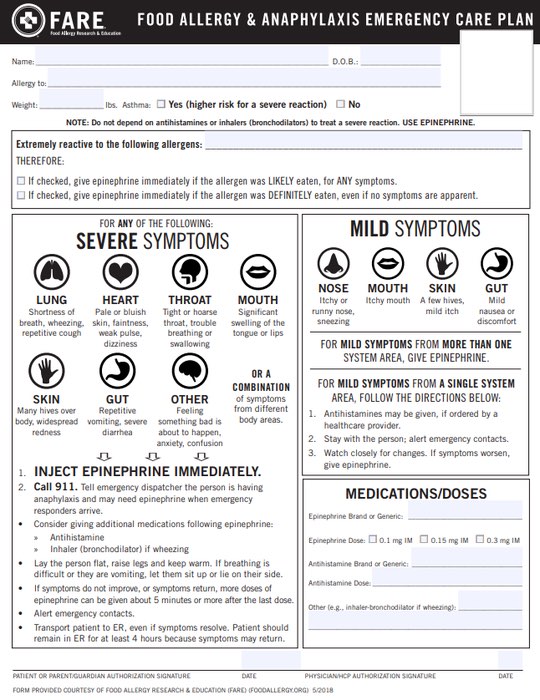Dealing with a Child’s Food Allergies
- Details
- Written by Joanne Wallenstein
- Category: Health
 (Submitted by Debra Etelson, Pediatrics at White Plains Hospital.)
(Submitted by Debra Etelson, Pediatrics at White Plains Hospital.)
Many parents and guardians, especially those with children going to daycare or school for the first time, are understandably concerned about whether the facility, its staff, and its other attendees are taking proper precautions when it comes to food allergens.
The good news is that any reputable, licensed establishment – by law – must do so. But that does not necessarily mean that one’s anxiety can simply be put away.
According to the nonprofit Food Allergy Research and Education (FARE), about 8% of children under the age of 18 have food allergies – equal to one in 13 children, or approximately two in every classroom. Eggs, milk, and peanuts are among the most common causes of food allergies in children, with wheat, soy, and tree nuts also included. Fish and shellfish are also on the list, though of course those are rarely served in schools or daycare centers.
Determining what foods your child may be allergic to can be complicated, but it needn’t be. Obviously if the child  suddenly has trouble breathing, or experiences cramps, swelling, vomiting or diarrhea, a trip to the emergency room is necessary. But before such symptoms occur, a simple blood test or a scratch test performed by an allergist can raise the appropriate red flags.
suddenly has trouble breathing, or experiences cramps, swelling, vomiting or diarrhea, a trip to the emergency room is necessary. But before such symptoms occur, a simple blood test or a scratch test performed by an allergist can raise the appropriate red flags.
Research has shown that children may outgrow some of these allergies before they’re five, although allergies to peanuts, tree nuts, fish and shellfish are usually lifelong.
Follow-up tests for someone who does have a food allergy usually take place every one to two years, and pediatricians will review allergies at each visit to track any changes. If the child has outgrown an allergy, there may be whole new edible worlds for them to explore – liberalizing a kid’s diet can be amazing.
Some food sensitivities and/or allergies may not be immediately apparent. Hives or tongue-swelling may occur when eating certain fruits and vegetables, but those reactions rarely progress to something more serious. You may see a reaction to raw carrots or apples, but not cooked ones, as cooking reduces the allergenic proteins and thus lowers the impact they have on the immune system.
When Kids Are in Someone Else’s Care
It may be relatively easy to monitor your child’s food intake at home, but what if they’re off to school or a playdate? Schools require the completion of a food allergy sheet like the one below before the term begins. This, along with a supply of Benadryl and/or an EpiPen, should help ease fears about your child being away for the day. In addition, many schools now prohibit peanuts and some other allergy-producing foods from the premises, eliminating the chances of an airborne infection.

Similarly, if your child is going to another home where you will not be present, converse with that caregiver and provide the appropriate medications. In all cases, remember that EpiPens are effective for 12 to 18 months, and like any other medication, will likely require a refill/replacement somewhere down the line. Also keep in mind that as your child ages, they begin to seek more independence, generally when they’re 10 or 11. That means they may don’t always carry their EpiPen or medication with them, so take the time to explain the importance of responsibility (and not just in this area of life!).
The FDA’s Pulmonary-Allergy Drug Advisory Committee (PADAC) voted 16-6 in favor for adults, and 17-5 in favor for children (under 18 years of age and weighing 66 or more pounds), acknowledging that available data supported a favorable benefit-risk assessment for neffy in the treatment of severe allergic reaction (Type 1), including anaphylaxis, for adults and children who weigh more than 66 pounds.
 Taking care of a child with a food allergy can be challenging, but being aware of what’s available and discussing the issues frankly with a pediatrician and other caregivers in your kid’s life should take at least a little worry out of the equation.
Taking care of a child with a food allergy can be challenging, but being aware of what’s available and discussing the issues frankly with a pediatrician and other caregivers in your kid’s life should take at least a little worry out of the equation.
Dr. Debra Etelson is a board-certified pediatrician at White Plains Physician Services in Somers. To make an appointment, call 914-849-7075.
Health Matters
The original version of this article was published in Health Matters, a White Plains Hospital publication.
County Officials Confirm Bear Attack in Bedford
- Details
- Written by Joanne Wallenstein
- Category: Health
 This photo of a bear in Heathcote was taken in May, 2020The Westchester County Department of Health has confirmed today that the bear that attacked a 7-year old boy in Bedford as he played in his backyard on Tuesday August 22, 2023 has tested negative for rabies. The child is being treated and the bear was shot by authorities shortly after the attack.
This photo of a bear in Heathcote was taken in May, 2020The Westchester County Department of Health has confirmed today that the bear that attacked a 7-year old boy in Bedford as he played in his backyard on Tuesday August 22, 2023 has tested negative for rabies. The child is being treated and the bear was shot by authorities shortly after the attack.
Residents should never approach or have contact with a stray or wild animal. Residents who see a stray or wild animal acting strangely should alert local authorities to avoid possible exposure to rabies. Residents can also help by keeping their trashcan lids securely sealed, removing wild bird feeders, and avoid leaving pet food outdoors.
Health Commissioner Sherlita Amler, MD, said: “If you see an animal that is acting aggressively, stay away from it and contact local police immediately.”
Unusual behavior may be the first sign of rabies in an animal. A rabid animal may become either abnormally aggressive or unusually tame. It may lose fear of people and become excited and irritable, or, conversely appear particularly passive and lethargic. Staggering and frothing at the mouth are sometimes noted.
Any physical contact with a wild or unfamiliar animal should be reported to a health care provider. All animal bites or contacts with animals suspected of having rabies must be reported to the Westchester County Department of Health at (914) 813-5000, 24 hours a day.
Keeping pet rabies vaccinations up to date is also important for protection against rabies. New York State law requires dogs, cats and ferrets to be vaccinated against rabies and receive regular booster shots. For more information, go to www.westchestergov.com/health or call the RABIES INFOLINE at (914) 813-5010.
Understanding Juvenile Arthritis
- Details
- Written by Joanne Wallenstein
- Category: Health
 This article was submitted by Dr. Tamar Rubinstein, Pediatric Rheumatology at White Plains Hospital
This article was submitted by Dr. Tamar Rubinstein, Pediatric Rheumatology at White Plains Hospital
Although arthritis is commonly associated with older people, it can also impact children. In fact, arthritis is the most common rheumatologic condition to affect children.
Juvenile arthritis (JA) refers to a group of autoimmune and inflammatory conditions that affect children under the age of 16. Just like arthritis in adults, JA involves chronic joint inflammation, which leads to stiffness, swelling, and pain. While some arthritis in children is associated with infectious causes such as Lyme Disease (caused by deer tick bites), the exact causes of JA remain largely unknown, but are likely a combination of genetic, environmental, and immunological factors.
The most common form of JA is Juvenile Idiopathic Arthritis, which according to the Arthritis Foundation is estimated to affect more than 300,000 kids in the U.S.
But other diseases can also lead to arthritis in children, including lupus, inflammatory bowel disease, and other, rarer autoimmune diseases.
The symptoms of juvenile arthritis may vary from child to child, but they often include joint pain, swelling, tenderness, morning stiffness, limited range of motion, and difficulty with everyday activities. Since these symptoms can mimic other conditions, a thorough evaluation by a pediatric rheumatologist is crucial for an accurate diagnosis. While the physical exam, evaluation, and careful review of the patient’s medical history are the most important part of diagnosing JA, sometimes blood tests and imaging scans help secure the diagnosis and ensure the differentiation from other mimickers of arthritis.
Although there is currently no cure for juvenile arthritis, early diagnosis and treatment is critical to manage symptoms, prevent joint damage, and improve a child’s quality of life – not only during childhood, but as they grow into adulthood. Treatment plans are tailored to the individual child and may involve oral medications, injectable medications, joint injections, and physical therapy.
Major advances in the treatment of autoimmune diseases and JA have been made over the past several decades, including the use of “biologics,” the newest class of medications used to treat JA. Encouraging a well-balanced diet, regular exercise, healthy sleep, and stress management are all important aspects of ensuring that children with JA achieve, and remain in, optimal health.
It should also be noted that JA can take a serious emotional toll on children and families. It is not uncommon for children with JA to struggle with anxiety or depression. These symptoms can seriously impact a child’s development, social wellbeing, and even their physical health. But when mental health symptoms are detected early, they can be addressed and treated to ensure that children with JA have the best possible long-term physical and emotional health outcomes.
Strategies to partner families with social and emotional support are especially important in youth who have JA. Professional mental health support, JA support groups and JA peer mentorship, and community resources all play an important role. To learn more about JA, you can visit the Arthritis Foundation webpage. Information about JA support groups can be found here.
To learn more about JA, you can visit the Arthritis Foundation webpage. Information about JA support groups can be found here.
Dr. Tamar Rubinstein is a Pediatric Rheumatologist at the Children’s Hospital at Montefiore (CHAM) who also sees patients at White Plains Hospital’s Montefiore Pediatric Subspecialty office at 33 Davis Ave. in White Plains. To make an appointment, call 914-849-5437.
Health Matters
The original version of this article was published in Health Matters, a White Plains Hospital publication.
Freeing Patients from Shoulder Pain
- Details
- Written by Joanne Wallenstein
- Category: Health
 The following was submitted by Dr. Michael Gott from White Plains Hospital
The following was submitted by Dr. Michael Gott from White Plains Hospital
Often when a patient hears the words “shoulder replacement,” they fear it means a loss of shoulder mobility for months and a long rehabilitation. Not so, assures Dr. Michael Gott, an Orthopedic Surgeon in the Center for Orthopedics and Spine Surgery at White Plains Hospital.
“Because it is not as common as knee or hip replacements, the misconception arises that this surgery entails removing and reattaching bones, tendons, and muscles,” he says. In fact, the procedure is technically a shoulder resurfacing, replacing just millimeters of damaged arthritic bone. During the procedure, Dr. Gott, guided by a CT scan, makes a tiny incision in the upper arm to insert a smooth titanium-alloy implant.
“CT-guided shoulder resurfacing is life-changing for those with end-stage shoulder arthritis, where the cartilage has worn away to create painful bone-on-bone friction,” says Dr. Gott.
Many of the patients the surgeon treats have had prior surgeries, multiple shoulder dislocations or just significant arthritis. Heavy lifting on the job or at the gym can exacerbate the pain. Some patients can no longer even lift their arms all the way up. These patients have exhausted all other options before electing to have the surgery.
“Injections only work for a few weeks or months, and medications have their own side effects,” Dr. Gott says. “And while physical therapy can be helpful for certain shoulder issues, it doesn’t address the damage to the joint that characterizes arthritis.”
For patients hesitant to embrace the idea of resurfacing, Dr. Gott points out the following advantages:
OUTPATIENT PROCEDURE. The patient receives local nerve blocks to numb the affected shoulder, undergoes an hour-long procedure, then receives a sling and returns home the same day. “Shoulder resurfacing requires fewer pain medications and a shorter recovery than even arthroscopic rotator-cuff repairs,” he explains.
MINIMALLY INVASIVE. Technological breakthroughs allow for tiny incisions and implants, removing a slice of bone that can fit on a fingernail. Rather than force metal into the bone, Dr. Gott slides titanium implants close to the joint.
PRECISION APPROACH. Dr. Gott’s team often creates 3D-printed models of a patient’s shoulder in advance to guide their approach during the procedure. “Studying the model cuts down on operating time and enhances accuracy. This focus on precision makes our outcomes even better,” he says.
RAPID RECOVERY. “As soon as they start physical therapy, patients tell me that they see a noticeable improvement in their strength and ranges of motion. They are also sleeping better within weeks, as opposed to months,” he notes. Following the procedure, patients typically require three months of supervised physical therapy, followed by exercises performed on their own as needed. They can then return to non-weight-bearing physical activities, such as golf, tennis, pickleball and racquet sports.
LOGISTICAL EASE. “Patients receive their consultations, CT scans, surgery, and follow-up care in the same location at our state-of-the-art Center for Advanced Medicine and Surgery,” Dr. Gott says. In addition to convenience, getting to know the care team promotes peace of mind for patients.
 In the end, Dr. Gott’s patients say they are grateful to have shrugged off their anxiety. “The most common feedback I hear from patients is that they only wish they had done the procedure sooner,” he says. “They not only recover — they bounce back even better.”
In the end, Dr. Gott’s patients say they are grateful to have shrugged off their anxiety. “The most common feedback I hear from patients is that they only wish they had done the procedure sooner,” he says. “They not only recover — they bounce back even better.”
Dr. Michael Gott Dr. Michael Gott is an orthopedic surgeon at the Center for Advanced Medicine and Surgery in White Plains. To make an appointment, call 914-849-7897.
Health Matters: The original version of this article was published in Health Matters, a White Plains Hospital publication.
How to Get Rid of Spotted Lanternflies
- Details
- Written by Joanne Wallenstein
- Category: Health
 There’s no denying it. The invasive Spotted Lanternflies are here. Before they eat up our trees and gardens what can we do? Practically speaking, how do we eliminate these harmful pests?
There’s no denying it. The invasive Spotted Lanternflies are here. Before they eat up our trees and gardens what can we do? Practically speaking, how do we eliminate these harmful pests?
Here’s a list of helpful recommendations from the French and Pickering Creeks Conservation Trust French and Pickering Creeks Conservation Trust on how to get rid of the invaders:
Smushing the bugs is effective and the method that is least harmful to the environment. If the flies are on a hard surface, fly swatters and whiffle ball bats work. If you miss the first time, DON’T GIVE UP! Lanternflies jump GREAT the first time, not so good the second time, and then they lose energy. If you follow the bug, you will get it on the second or third try! Always try to come at the bugs from in front; they see better behind them. For the techies out there, there are special electric tennis rackets made for this – Zap-It, twin bug zappers – the first zap stops them from flying, then you can squash or zap again.
Smush again! If you are outside without your fly swatter, and you see one bug and want to smush it, this technique is foolproof (but not good if you are squeamish). Very, very SLOWLY, put one hand in front of the bug. Very, very SLOWLY, put one hand behind the bug. Very, very SLOWLY, bring your back hand towards your front hand until you have the bug trapped between your hands. You can then squish it, step on it, or drop it in a jar or tub of water and quickly put the lid on.
Another method for catching many adults on a tree or on the side of a house is to use a shop vac. A shop vac will suck them up quickly and they will be gone. If you don’t own a shop vac, you can buy a small bucket-sized one on Amazon or in many local stores.
The sticky paper plus hose method: If you have a tree with a bad infestation of lanternflies, wrap wide sticky paper or several strips of thinner sticky paper or inside-out duct tape around the bottom of the tree. Get out your hose or pressure washer and spray the bugs with water – or get out your leaf blower and spray the bugs with air – or knock the tree limbs with a broom – so they fall off the tree. They will scramble to climb back up the tree, and they will get caught on the sticky paper. You may need to replace the sticky paper if it starts to fill up with lanternflies. Once most of the bugs have returned to the tree and been captured, remove the paper from your tree and fold it back on itself. Never leave sticky paper unattended because it can harm beneficial insects and birds and other wildlife.
Bug Assault is a gun that shoots table salt at close range, and it works great on lanternflies. Here is a link to one that works: With older flies, the first shot may not kill them, but it will stun them, and then you can squish or step on. Air guns and BB guns with no BB’s also kill them! To quote: just pump 4 to 5 times, get really close to them and pow, blown to smithereens!!
Plant more milkw Experts suggest the removal of invasive Alianthus trees (Tree of Heaven) as they attract Spotted Lanternflies.Alinathus Tree, or Tree of Heaven is an invasive tree that attracts Spotted Lanternflieseed! It appears that the lanternflies are attracted to Common Milkweed. We find dead lanternflies on it every day. The lanternflies are new here, and they don’t know it is poisonous, so they eat it and it kills them. The poisonous sap also slows them down, so they are much easier to catch and smush in your hand. At the very least, you will be helping save the Monarch Butterfly and helping other pollinators, who love the flowers.
Experts suggest the removal of invasive Alianthus trees (Tree of Heaven) as they attract Spotted Lanternflies.Alinathus Tree, or Tree of Heaven is an invasive tree that attracts Spotted Lanternflieseed! It appears that the lanternflies are attracted to Common Milkweed. We find dead lanternflies on it every day. The lanternflies are new here, and they don’t know it is poisonous, so they eat it and it kills them. The poisonous sap also slows them down, so they are much easier to catch and smush in your hand. At the very least, you will be helping save the Monarch Butterfly and helping other pollinators, who love the flowers.
If you are dying to spray them with something, these pesticides are endorsed by Penn State as excellent at killing them on contact, but they don’t stay long on surfaces, so they should do the least harm to the beneficial insects we need: Purely Green, Spotted Lanternfly Killer 2 (active ingredient essential oils); Bonide Neem Oil (active ingredient Neem); Garden Safe Multi-Purpose Garden Insect Killer, Natria Insect Mite and Disease Control (active ingredient natural pyrethrins; and Garden Safe Insecticidal Soap (active ingredient insecticidal soap).
Don’t remove your spider webs! Spiders are catching lanternflies in their webs every day. Some of our spiders are learning to eat them. They will do lanternfly removal for you.
Remove Tree of Heaven from your property and replace it with a native tree. There is a strong relationship between Tree of Heaven (Ailanthus) and the Spotted Lanternfly – they love it. Tree of Heaven is an invasive, noxious plant that produces ailanthone, a chemical which has been reported to possess herbicidal activity similar to glyphosate (Round-Up) and paraquat. It prevents native plants from growing around it. Removing Tree of Heaven from your property is always a good idea. You may need a professional to do this.
When trying to handle a nymph: Leave out trays of water. Some people add some lemon oil. For some reason, they climb in the tray and drown. Our use The Tupperware Tub method – you can catch oodles of nymphs in a very short time. You will need a Tupperware tub, margarine container, or large yogurt container with a tight-fitting lid. Put a couple inches of a 50/50 mix of vinegar and water in the bottom. Hold the tub under a branch on which there are nymphs. Tap the branch from above, the nymphs fall in the liquid, slap the lid on, and the nymphs will drown within 15 seconds. You can save the liquid for next time. Remember, never pour this liquid on the ground – pour it down your garbage disposal or toilet.
Spotted Lanternfly Eggs Masses start appearing in early fall. They are grey or brown globby 2-4″ smears that look a bit like old chewing gum on trees, cement blocks, rocks, cars, houses, barbecue grills – any hard surface. The good news is this is the easiest phase to get rid of – you can scrape them off using a plastic card, like a credit card or a putty knife. Scrape them into a small baggie or container filled with isopropyl alcohol or hand sanitizer. This is the most effective way to kill the eggs, but they can also be smashed or burned. Remember that some eggs will be laid at the tops of trees and may not be possible to reach.
Do you have ideas on how to get rid of lantern flies? Post them in the comments section below:














